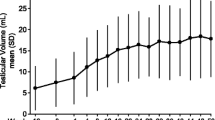Abstract
Objective
To investigate the therapeutic and adverse effects of Tripterygium hypoglaucum (Lévl.) Hutch (THH) in treating proteinuria of renal transplant recipients.
Methods
Thirty patients with proteinuria greater than 1 g/24 h were enrolled to be treated with one tablet preparation of THH extract (360 mg, 3 times daily, equivalent to triptolide 30 μg/d) for 6 months. The proteinuria, serum creatinine, sex hormones, semen analysis and erectile function in male were determined at entry, 3 and 6 months. Incidence of adverse events was evaluated.
Results
THH treatment significantly improved proteinuria (from 2.52±1.87 g/d at baseline to 1.11±0.96 g/d at 3 months, and to 1.04±1.09 g/d at 6 months). No significant changes were observed in serum creatinine, liver enzymes or complete blood count. In female (15 cases), THH treatment induced a significant increase in follicle stimulating hormone and luteinizing hormone levels, and a significant decrease in estradiol and progesterone levels, and the main adverse effects were reversible menstrual irregularities (73.3% at 6 months). In male (15 cases), the sperm concentration and viability were markedly decreased by THH treatment, but the sex hormone levels and erectile function did not change significantly by treatment.
Conclusions
THH is effective and safe for the treatment of proteinuria in renal transplant recipients. Its primary adverse effect is reversible toxicity to reproductive organs. Further controlled clinical trials are warranted to determine the true clinical benefit of THH.
Similar content being viewed by others
References
Amer H, Fidler ME, Myslak M, Morales P, Kremers WK, Larson TS, et al. Proteinuria after kidney transplantation, relationship to allograft histology and survival. Am J Transplant 2007;7:2748–2756.
Roodnat JI, Mulder PG, Rischen-Vos J, van Riemsdijk IC, van Gelder T, Zietse R, et al. Proteinuria after renal transplantation affects not only graft survival but also patient survival. Transplantation 2001;72:438–444.
de Zeeuw D, Remuzzi G, Parving HH, Keane WF, Zhang Z, Shahinfar S, et al. Proteinuria, a target for renoprotection in patients with type 2 diabetic nephropathy: lessons from RENAAL. Kidney Int 2004;65:2309–2320.
Ruggenenti P, Perna A, Remuzzi G. Retarding progression of chronic renal disease: the neglected issue of residual proteinuria. Kidney Int 2003;63:2254–2261.
Hiremath S, Fergusson D, Doucette S, Mulay AV, Knoll GA. Renin angiotensin system blockade in kidney transplantation: a systematic review of the evidence. Am J Transplant 2007;7:2350–2360.
Brinker AM, Ma J, Lipsky PE, Raskin I. Medicinal chemistry and pharmacology of genus Tripterygium (Celastraceae). Phytochemistry 2007;68:732–766.
Lin LM, Qi XM. Comparative observation on the effects of Radix tripterygium hypoglaucum tablet and Tripterygium glycosides tablet in treating erosive oral lichen planus. Chin J Integr Med 2005;11:149–150.
Teng LC, Wang CX, Chen L. Improved erectile function and sex hormone profi les in male Chinese recipients of kidney transplantation. Clin Transplant 2011;25:265–269.
Li S, Wang X. HPLC determination of triptolide in Kunming Shanghaitang tablets. Chin J Pharm Anal (Chin) 2008;28:1150–1152.
Li SY, Zhang C, He L, Nong X. The clinical use of Tripterygium hypoglaucum (Lévl.) Hutch. Chin J Ethnomed (Chin) 2006;15:325–330.
Hu SH, Pi XM, Li H. A combination oral therapy with fibraurea stem tablet and dapsone in treatment of 64 cases with posriasis valgrais. Chin J Derm Venereol (Chin) 2004;18:34.
Wang YM, Pan H. Report of fibraurea stem tablet in the treatment of 120 cases with corticosteroid dependent dermatitis. Chin J Derm Venereol (Chin) 2002;16:314–315.
Fujita R, Duan H, Takaishi Y. Terpenoids from Tripterigyum hypoglaucum. Phytochemistry 2000;53:715–722.
Qian SZ, Hu YZ, Wang SM, Luo Y, Tang AS, Shu SY, et al. Effects of Tripterygium hypoglaucum (Levl.) Hutch on male fertility. Adv Contracept 1988;4:307–310.
Zhou JW, Pan RN, Liu LW, Peng L, Luo Y, Zhang XM, et al. Preliminary studies on Tripteryguim hypoglaucum (Levl.) Hutch inhibition on fertility in rat. Med Pharm Yunnan (Chin) 1991;14:232–235.
Gu WZ, Chen R, Brandwein S, McAlpine J, Burres N. Isolation, purification, and characterization of immunosuppressive compounds from tripterygium: triptolide and tripdiolide. Int J Immunopharmacol 1995;17:351–356.
Ma J, Dey M, Yang H, Poulev A, Pouleva R, Dorn R, et al. Anti-infl ammatory and immunosuppressive compounds from Tripterygium wilfordii. Phytochemistry 2007;68:1172–1178.
Tao X, Cai JJ, Lipsky PE. The identity of immunosuppressive components of the ethyl acetate extract and chloroform methanol extract (T2) of Tripterygium wilfordii Hook. F. J Pharmacol Exp Ther 1995;272:1305–1312.
Zheng CX, Chen ZH, Zeng CH, Qin WS, Li LS, Liu ZH. Triptolide protects podocytes from puromycin aminonucleoside induced injury in vivo and in vitro. Kidney Int 2008;74:596–612.
Chen ZH, Qin WS, Zeng CH, Zheng CX, Hong YM, Lu YZ, et al. Triptolide reduces proteinuria in experimental membranous nephropathy and protects against C5b-9-induced podocyte injury in vitro. Kidney Int 2010;77:974–988.
Liu J, Jiang Z, Liu L, Zhang Y, Zhang S, Xiao J, et al. Triptolide induces adverse effect on reproductive parameters of female Sprague-Dawley rats. Drug Chem Toxicol 2011;34:1–7.
Ni B, Jiang Z, Huang X, Xu F, Zhang R, Zhang Z, et al. Male reproductive toxicity and toxicokinetics of triptolide in rats. Arzneimittelforschung 2008;58:673–680.
Kitzen JJ, de Jonge MJ, Lamers CH, Eskens FA, van der Biessen D, van Doorn L, et al. Phase I dose-escalation study of F60008, a novel apoptosis inducer, in patients with advanced solid tumours. Eur J Cancer 2009;45:1764–1772.
Kiviharju TM, Lecane PS, Sellers RG, Peehl DM. Antiproliferative and proapoptotic activities of triptolide (PG490), a natural product entering clinical trials, on primary cultures of human prostatic epithelial cells. Clin Cancer Res 2002;8:2666–2674.
Dudley C, Pohanka E, Riad H, Dedochova J, Wijngaard P, Sutter C, et al. Mycophenolate mofetil substitution for cyclosporine a in renal transplant recipients with chronic progressive allograft dysfunction: the “creeping creatinine” study. Transplantation 2005;79:466–475.
Author information
Authors and Affiliations
Corresponding author
Rights and permissions
About this article
Cite this article
Yuan, Xp., Fu, Q. & Wang, Cx. Effect and safety of Tripterygium Hypoglaucum (Lévl.) hutch in treating proteinuria of kidney transplant recipients. Chin. J. Integr. Med. (2014). https://doi.org/10.1007/s11655-014-1688-7
Received:
Published:
DOI: https://doi.org/10.1007/s11655-014-1688-7




